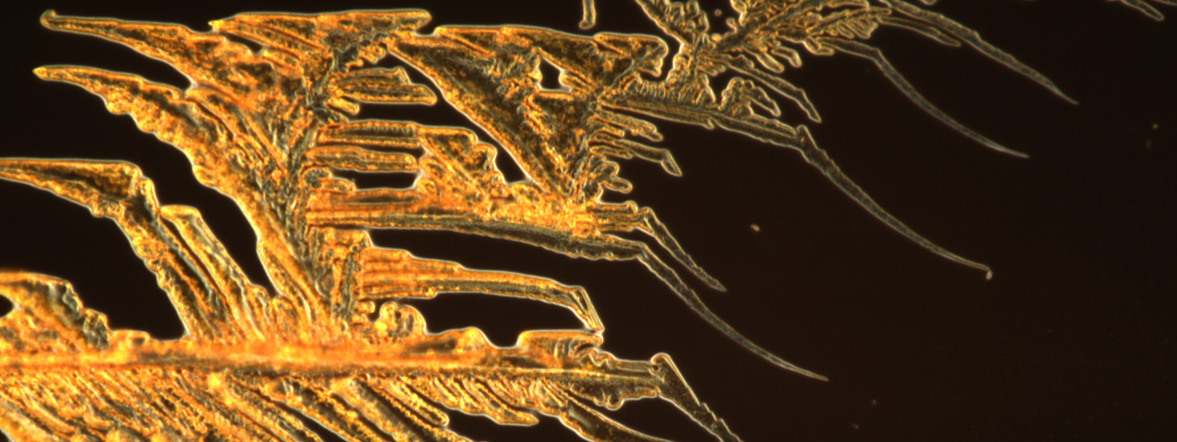Research in this area is based on exploring the possibilities for functional materials based on systems other than metal oxides. Fitting nicely with the “Green Chemistry” research avenue this area focuses on supramolecular and composite material systems for functional applications like piezoelectric sensors, capacitors, thermal energy storage, caloric materials, and ionic conduction. The goal of this research is to explore how to best engineer the desired functional properties in each material system, using compositional engineering and material synthesis. We tune both the molecule chemistry and create solid solutions to modify key material properties like, transition temperatures, structure, polarization and electromechanically responses. The focus is on understanding composition-structure-property relationships in new material systems through experimental studies in the laboratory, supported by theory based computational investigations.
Research interests
Dielectrics
Materials with high dielectric polarizability perform vital roles in our electronics, most notably as multilayer ceramic capacitors (MLCC), of which over 400 are found in a mobile phone alone. The technological applications for MLCCs are expanding as our reliance on electrical energy continues to grow. Currently metal oxides make up the bulk of the dielectric materials market and avenues for recycling are slim. Hybrid supramolecular materials that are soluble in various solvents may have significantly greater recyclability but presently face challenges with low dielectric polarizability and high electrical leakage. One avenue of FACET research is focused on addressing these challenges through compositional engineering of hybrid supramolecular materials, improving resistivity and dielectric breakdown strength while maximizing susceptibility to electric fields. There are many approaches, including controlling molecular orientational freedom to engineer relaxor-like phases with large polarizations or enhancing anisotropic intermolecular interactions to produce anti-ferroelectric phases that can produce large polarizations and dielectric responses through reversible electric field induced phase transitions.
Electromechanical properties
The hybrid materials systems have recently demonstrated promising electromechanical properties, with piezoelectric coefficients over 100 pC/N. This large piezoelectric response in combination with small dielectric constant makes hybrid supramolecular materials well suited to sensing and energy harvesting applications. As well as this several compositions exist with hexagonal wurtzite-like crystal structures which confined by symmetry to possess only ferroelectric (180 degree) domains. These materials have small (>5 pC/N) but stable piezoelectric coefficients and thus may be useful for applications occupied by their nitride structural analogue AlN. Learning how to engineer the functional properties that will enhance the materials functionality in these applications is a key focus of FACET and is intended to drive new applications areas as well as allow us to explore the recyclability and low temperature synthesis potential of hybrid materials.
Thermal energy Storage
Increasing demand and cyclic use of electricity throughout the day is leading to soaring electricity prices, as experienced in December 2021 around southern Norway. Storing thermal energy during off peak periods of the day to reduce energy consumption during peak periods is a important solution for our energy future. Hybrid materials consisting of molecular components that can have different degrees of orientational freedom, and there fore large entropy phase transitions are promising materials for this application. The FACET groups is investigating ways of engineering the key phase transition properties of hybrid molecular materials to make them suitable for a wide variety of thermal storage applications. Controlling the steric hinderance experienced by molecules as well as the intermolecular interactions is critical for modifying the entropy and temperature of the phase transitions in these materials, and FACET is exploring compositional engineering strategies for a wide range of hybrid molecular materials systems.
Computational and experimental approaches
In all application areas the FACET group employs a combined approach of investigation based on empirical experiments, computation and theory. New compositions are produce in the lab via solution chemistry and crystallizations for further thermodynamic, structural and electromechanical characterization. Computational approaches focus on the local molecular energies and interactions using density functional theory and molecular dynamic modeling approaches. The large unit cells, complex chemistries and orientational disorder create significant challenges for computational modelling and FACET is working on overcoming these to help discover new materials compositions as well as define effecting modelling approaches for these complex material systems.
For synthesis and characterization we rely on a combination of FACET laboratories and equipment, strategic collaborations with research partners and use of larger scientific user facilities.
Computational and experimental approaches:
Structural characterization:
Computational Investigations:
Functional characterization:
- Differential scanning calorimetry (Polyma)
- Dielectric spectroscopy as a function of temperature and voltage (Novotherm)
- Piezoelectric and electromechanical testing (Axiacct piezo analyzer)
J. Walker, K. P. Marshall, J. Salgado-Beceiro, B. A. D. Williamson, N. S. Løndal, S. Castro-Garcia, M. S. Andújar, S. M. Selbach, D. Chernyshov and M.-A. Einarsrud
Mesophase transitions in [(C2H5)4N][FeBrCl3] and [(CH3)4N][FeBrCl3] ferroic plastic crystals
ACS Chem. Mater. (2022)
J. Walker, S. Scherrer, N. S. Løndal, T. Grande and M.-A. Einarsrud
Domain switching in ferroelectric tetramethylammonium bromotrichloroferrate(III) plastic crystals
Appl. Phys. Lett. 116 (2020) 242902.
J. Walker, R. Miranti, S. L. Skjærvø, T. Rojac, T. Grande and M.-A. Einarsrud
Super-coercive electric field hysteresis in ferroelectric plastic crystal tetramethylammonium bromotrichloroferrate(III)
J. Mater. Chem. C 8 (2020) 3206-3216.

